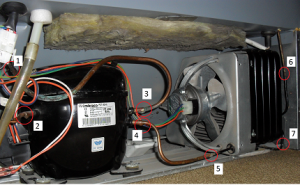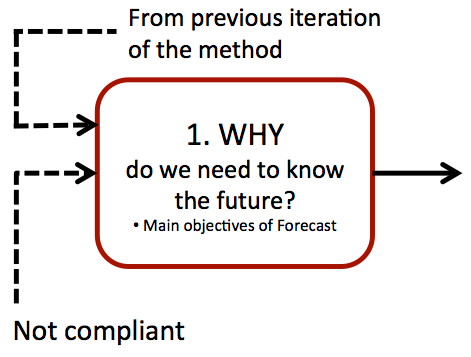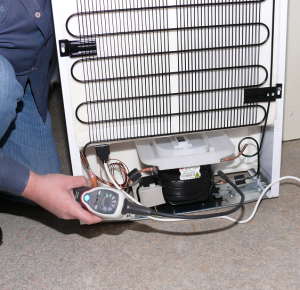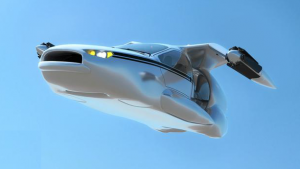Prepare objectives of the project/study from various viewpoints (e.g. beneficiaries, users, technology context, marketing context)
MethodMethod = FORMAT methodology
The key question to be answered in this step is Why do we need to know the Future? The answer to the above question will constitute the main objectives of the project. Main objectives have to be approached from two perspectives at least. First, the context perspective: Why is this objective relevant? Second, is the results perspective: when the objective is met, how will it be applied to the decision making process?
Instructions
- Identify the main objective of the project and write down what beneficiaries and users would like to know about future changes in the analysed technology.
- The stated objectives should be verified using the question: Why do we need to know the future? This question refers to the super-system (context of technology) (e.g. decision making, business strategy, economics, financial aspects).
- During the first working session, get an answer to the following questions: What are the expected results of the forecasting project for users and beneficiaries?
- What is the main function of the industrial process?
- What forecasting question(s) should be answered for taking intelligent and informed decision(s)?
- What would support the main questions and which among them are the most important?
- What is the necessary level of details when answering forecasting question(s)?
- What is the form (e.g. roadmap, set of recommendation, list of answers, graphs, charts, report, video) in which results need to be presented?
- During first session(s), get answers to: how will the results of the forecast be applied?
- Is the forecast result required by some other decision making process? Which one?
- When will the results be applied (e.g. two years later, two quarters later)?
- Where will the results be applied (e.g. strategic planning, selecting suppliers)?
- Who will use these results? Who may gain from the acquired knowledge?
Tips
➔ Before first working session..
- Ask the team leader for materials to learn about the subject of the project and about the system to be forecasted (STFSTF = System to be forecasted ) – list of references.
- Prepare a draft list of questions to be answered by forecast based on materials supplied by the organization on the subject of the impending forecast. The list can serve as a starting point for discussion and developing a shared vision of the key questions.
➔ Examine sources of information from the list of references collected earlier.
➔ During first working session. Audio and/or screen recordings of the meetings is recommended as a future reference.
➔ After first working session. Prepare a set of slides from the first working session (1-2 working days).
➔ In order to create a draft version of a report at the end of the project, write comments and notes in the notes section of the slides in the slide deck.
To prepare the set of slides for the subsequent working session, utilize the audio and/or screen recordings of the first working session.
Suggested reading
Ackoff, R. L. (2006), “Thinking about the future”.
Ackoff, R. L. (2006), “A major mistake that managers make”
Example
Brief context – There are different types of super-capacitors for storage of electrical energy. For many of these types, scientific research may be required. However,to conduct research on several types of these super-capacitors, laboratories may require significant financial, technical and human resources. As an alternative, it may be possible to focus available funding on one of these types of super-capacitors. In the latter case, there is a risk that in 10-15 years, the market may be dominated by another type of super-capacitors, that were not researched as result of the decision to focus on one type.
Step 1: Why do we need to know the future?
We need to know the future of super-capacitors for long-term planning of a research laboratory.
Brief Context – A refrigerator consists of parts made of different materials. These parts work under cyclic loading, vibration, various temperatures and pressure differences. These parts must be combined into a sealed system. The individual parts of the system must be leak-proof and when sealed together, the assembly should also be leak-proof.
Gas leak detection is the process of identifying potentially hazardous gas leaks using various sensors. These sensors are equipped with a sound alarm to alert people when dangerous gas has been detected.

Figure 2. Refrigerator system assembly. There are some connections between different parts of the system marked by numbers (1) – (7).
Step 1: Why do we need to know the future?
We need to know the future of gas leak checks in a refrigerator in order to understand when and how refrigerators will be produced without the need for gas leak checks.
Brief Context –A reputed car manufacturer established a subsidiary “Flying car” for the development and production of a future personal “Flying car”. Financial investor decides on long-term (20 years) placing part of their capital into shares of the company “Flying car”.
http://www.bbc.com/future/story/20131031-a-flying-car-for-everyone
Step 1: Why do we need to know the Future?
We need to know the future of the “Flying car” for helping decision making for the financial investor.
v2





